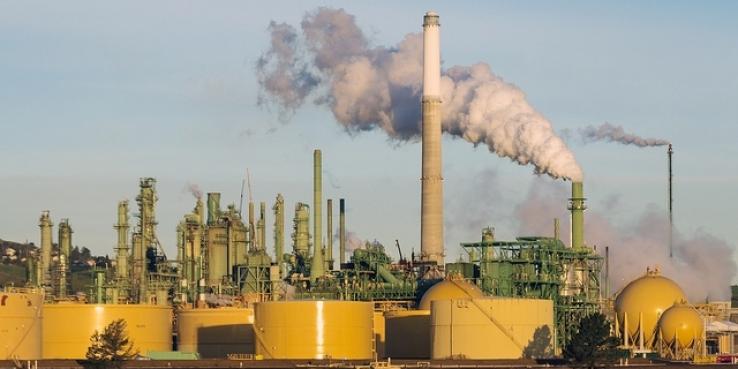In January, the California Air Resources Board proposed a plan to meet the state’s aggressive new climate target to reduce greenhouse gas (GHG) emissions 40 percent below 1990 levels across all sectors of the economy by 2030. The plan proposes a 20 percent reduction in emissions from oil refineries — the largest stationary sources of GHG emissions in the state — by requiring them all to achieve a benchmark of the most efficient refinery on a per-barrel basis. SPUR wrote about the Bay Area’s historic and already heavily regulated oil refineries in our recent report Fossil-Free Bay Area. Those who know our region for its forward-looking climate policies may be surprised to learn that most of our region’s five oil refineries are over 100 years old and are probably here to stay. What can be done about their significant contributions to local air pollution and to climate-changing emissions?
The Bay Area is home to five major historic oil refineries located in the cities of Richmond, Rodeo, Benicia and Martinez. These refineries produce about 800,000 barrels a day of gasoline from crude oil and represent about a quarter of California’s total refining capacity. They also produce jet fuel, diesel, lube oil, wax and other chemicals. They receive oil delivered in three ways: by tanker through marine terminals, from pipelines originating in the Central Valley and by rail from tar sand mines in Canada. About 38 percent of California’s oil is produced in state, 12 percent comes from Alaska and 50 percent comes from Saudi Arabia, Ecuador, Iraq, Mexico and other countries.
Four out of the Bay Area’s five refineries were built before 1915; the fifth was built in the late 1960s. Modernization projects costing more than $2 billion have been undertaken in the last ten years or are underway, including a project to upgrade the largest, Chevron’s Richmond refinery, in a way that will allow it to take in dirtier crude without increasing greenhouse gas emissions. In 2011, these five refineries released more than 14 million metric tons of CO2e emissions, the second-largest source of fossil fuel emissions in the Bay Area behind passenger cars and trucks, which emitted more than twice this amount.
Growing demand for gasoline and fossil fuel-powered transportation impacts the Bay Area twice: first in the release of emissions related to refining, second in the burning of the fuels themselves to power our transportation systems. By having gasoline-refining industry in our region, we experience the adverse effects of fossil fuel dependency on both the supply and demand sides.
And there are equity consequences for the region. The concentration of refineries in Contra Costa County has worsened air quality and health in Richmond, Martinez and Benicia. While the frequency of air quality emergencies and chemical spills has gone down over time with increased regulation, both these rare events and the daily toll of refining emissions are concentrated locally, and they disproportionately impact communities of color. The SB 32 Scoping Plan notes that many of the largest sources of the state’s GHG emissions are in disadvantaged communities, and restricting GHG emissions at refineries may help reduce other air pollution, including toxic air contaminants, in some of the most polluted and poorest areas of the state.
The Bay Area’s refineries are currently proposing to increase the import of crude by rail, which could add even more devastating risks, as illustrated by oil train derailments and explosions in Oregon, North Dakota, Virginia and Quebec. A 2014 Natural Resources Defense Council study found that crude-by-rail imports to California increased more than 100 times between 2009 and 2013. It also identified that 152,000 people and more than 90 schools in the Bay Area would be at risk from proposed rail projects as they are located within one mile of crude-by-rail routes. Railroads are federally regulated, and municipalities have little opportunity to understand the frequency or risk of oil trains in their vicinities, let alone control or reroute cargo to more remote or less sensitive areas. What they can do is evaluate — and reject — land use proposals that would site crude oil facilities near people or sensitive sites within their jurisdictions.
To address the refinery operations — but not the transportation — of fuels, the Bay Area Air Quality Management District has jurisdiction over what is emitted in the Bay Area. The district is working on a suite of regulations to reduce certain emissions from the refineries by 20 percent by 2020. The rules will also require continuous monitoring, limit pollution to within the fenceline of refinery facilities and ensure best practices. Cities in the region can support these efforts and request the most stringent regulations the Air District could impose.
Because we are still consuming gasoline and other fossil fuels — and it is almost impossible to site new refining facilities in California today — it seems likely that these five refineries will persist with us well into the 21st century. But we can support environmental justice and better health in the communities near them by making sure we limit new risks. This means rejecting new facilities and terminals, ensuring continuous safety improvement of the pipelines and equipment we already have, and reducing air emissions as deeply as possible through regulation, both at the regional and state level.
